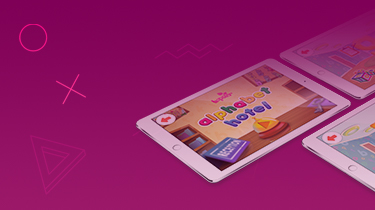
- ServicesCustom software development and consulting services we provide
- Solutions
- ExpertiseCustom-tailored solutions for enterprises and beyond, proven over 25+ years in business
- IndustriesKey industries and verticals we serve across countries and project types
- PortfolioLearn how hundreds of businesses succeed with the help of Program-Ace
- Who we areLearn how we differ from other R&D companies and why 150+ business owners trust us
- Careers
- Blog
- Contact Us

Educational Game Development
Looking for Educational Game Development Services?
As an educational game development company, we aim to transform traditional learning methods into captivating and interactive experiences. Leveraging the latest technology and best practices in interactive learning, our skilled team designs educational games that are more than just fun — they are a robust platform for delivering effective, measurable learning outcomes.
We cater to a wide array of industries, including healthcare, fintech, manufacturing, and more, providing tailor-made game development solutions that simplify complex concepts, boost knowledge retention, and stimulate user engagement. Our advanced educational games serve as powerful tools for enterprises, fostering continuous learning and nurturing productivity. Program-Ace is dedicated to revolutionizing how organizations learn, bringing innovation, effectiveness, and enjoyment to the forefront of corporate learning.
Educational Game Development Services We Provide
How We Did It Before








Program-Ace in Numbers
in Kharkiv, Ukraine
(by Clutch)
Companies (by IAOP)
IT employers in Ukraine
delivered projects
Why Choose Us for Educational Game Development
Our team's main priorities are trust and mutual respect. We work closely with you, ensuring your vision and goals are fully realized.
We harness the power of advanced technologies like AR, VR, and others, infusing your educational games with innovation and modernity.
Our extensive experience in game development equips us to create robust, immersive educational games, driving impactful learning.
At Program-Ace, transparency is key. We maintain clear, consistent communication, keeping you informed and involved throughout the development process.
FAQ
Educational games have revolutionized how people learn, blending entertainment and knowledge into a single, accessible platform. If you’re considering developing an educational game, understanding the cost implications is crucial. The price tag can vary significantly depending on several factors, including complexity, design requirements, technology used, and more. Here, we'll break down the factors that contribute to the cost of educational game development.
Scope and сomplexity
The scope and complexity of the game are key determinants of the overall development cost. A simple game with basic features and functionality will be significantly less expensive than a complex one with multiple features, levels, and intricate gameplay mechanics. Additionally, if your game requires a multiplayer setup, extensive narrative, AI-based adaptive learning, or other complex elements, the development cost will be higher.
Design requirements
The design aesthetic of a game is crucial to its success. Simple 2D games will cost less to design than complex 3D ones due to the reduced complexity of assets and environments. Costs can further increase if the game requires detailed artwork, character models, animations, or unique user interfaces.
Technology used
The technology utilized can significantly impact the cost. If you opt for emerging technologies like virtual reality (VR), augmented reality (AR), or artificial intelligence (AI), it will inflate the cost. However, these technologies can also create a more immersive, engaging, and effective learning environment.
Platform
The chosen platform, whether iOS, Android, PC, or cross-platform, also contributes to the cost. Each platform has its unique requirements, development complexities, and testing procedures. Cross-platform development might be a cost-effective solution, but it depends on the specific needs of the project.
Maintenance and updates
The cost doesn’t end when the game is launched. You must consider the costs of ongoing maintenance, updates, and adding new features or content over time. These factors ensure your game remains competitive, effective, and aligned with your evolving educational goals.
Creating a quality educational game involves an array of professionals. Here are some key players:
Game designers. They conceptualize the game and design its mechanics. They work on the storyline, rules, characters, and overall user experience.
Developers. These professionals write the code that brings the game to life. Their work is pivotal to the functioning of the game.
Graphic artists. They create the game’s visual elements, including characters, environments, and UI elements.
QA testers. They test the game for bugs and performance issues before it goes live, ensuring a smooth user experience.
Despite these general guidelines, every educational game project is unique, with specific requirements, goals, and challenges. Therefore, it’s crucial to perform a custom evaluation for each project to understand its specifics and accurately determine the cost. A tailored evaluation takes into account your game's unique objectives, target audience, required features, and other bespoke considerations.
An educational game is an investment in effective learning. By understanding the associated costs and factors affecting them, you can make informed decisions, aligning your educational goals with budgetary considerations. While costs may vary, working with a reputable game development company like Program-Ace ensures quality, reliability, and a worthwhile return on your investment. It’s important to remember that the most expensive game isn’t always the best. Instead, the best game is one that achieves your learning objectives, resonates with your audience, and provides a meaningful, enjoyable experience.
Educational games have increasingly become a popular tool for knowledge transfer, both in business training and children's education. Despite the common objective of imparting knowledge, designing an educational game for businesses and kids require different approaches due to the distinct nature of their audiences and educational goals.
The most significant difference between designing educational games for businesses and children is understanding the target audience's characteristics, learning abilities, interests, and motivations.
Children. Kids are still in their developmental stages, learning about the world around them. Their cognitive abilities, attention spans, and motor skills are still evolving. Thus, games need to be designed with simplicity, highly interactive elements, and visually engaging interfaces. They should be colorful, fun, and stimulating to maintain children's interest.
Business Professionals. Adults, specifically business professionals, have well-developed cognitive abilities and specific professional skills. They seek educational games that are relevant to their roles, challenging, and beneficial for their career progression. Games for businesses often have more complex mechanics, deal with abstract concepts, and focus on the real-world application of knowledge.
Learning goals significantly influence the design of the educational game.
Children. Educational games for children aim to develop basic skills such as reading, writing, and arithmetic, along with creativity, problem-solving, and social skills. The design should incorporate elements that encourage exploration, curiosity, and creativity.
Business Professionals. For business professionals, the goals lean towards advanced skills relevant to their job functions like leadership, strategic thinking, project management, or industry-specific knowledge. The design needs to be immersive, simulating real-world situations and decision-making scenarios.
How the educational content is developed and presented varies greatly.
Children. For kids, educational content needs to be woven into a compelling story or fun activities. The use of cartoon characters, mascots, and lots of visuals make learning enjoyable and less intimidating. Rewards, badges, and progress tracking can motivate kids and provide a sense of achievement.
Business Professionals. For business environments, content can be presented as real-world challenges, problem-solving tasks, or role-playing situations. The tone is more serious, and the content is grounded in reality. Gamified elements like leaderboards, points, or levels can fuel healthy competition and motivation.
Feedback mechanisms in games provide players with an understanding of their performance and areas of improvement.
Children. Feedback for kids needs to be immediate, positive, and encouraging to reinforce learning and maintain interest. A simple scoring system or visual cues indicating right or wrong answers can be effective.
Business Professionals. Feedback in games for businesses is more detailed, often providing insights into decision-making abilities, strategy, time management, etc. Analytics-driven assessments can be used to track performance and progress over time.
The choice of interface and technology also varies.
Children. For kids, the interface should be simple, colorful, and intuitive, with easy navigation. Touch-based mobile games or PC games are popular for this age group.
Business Professionals. For businesses, the interface can be more complex, reflecting the sophisticated nature of the content. In addition to mobile and PC games, virtual reality (VR) or augmented reality (AR) can be used for immersive training experiences.
As the demand for interactive learning experiences grows, educational game development has surged, transforming the traditional methods of education into dynamic, interactive digital experiences. Several platforms and technologies power these developments, each offering unique features and capabilities to cater to varying needs and target audiences.
Platforms
Personal computers (PCs). PCs have been a staple for educational games, especially in formal education settings. PCs support high-end graphics, larger screens, and sophisticated gameplay mechanics, making them suitable for complex educational games. They are ideal for classroom settings where students can learn collectively.
Mobile devices. Mobile-based educational games have seen a surge in popularity due to their portability and widespread usage. Games on iOS and Android can reach a wide audience and are particularly popular for younger learners who can play and learn on the go. Mobile games often have touch-based, intuitive interfaces and simpler gameplay mechanics.
Consoles. Although less common for educational games, consoles like Xbox, PlayStation, and Nintendo can offer more immersive gaming experiences. They are typically used for more interactive and engaging learning games, often targeted at an older demographic.
Web-based. Web-based educational games are platform-independent, running on any device with a web browser. They are accessible, easy to distribute, and do not require users to install anything on their devices.
Virtual Reality (VR) / Augmented Reality (AR). These platforms provide immersive experiences that enhance engagement and learning effectiveness. VR can create entirely virtual environments for exploration, while AR overlays digital information onto the real world. These platforms are excellent for simulation-based learning.
Game Development Engines
Unity. Unity is one of the most popular game development engines. It supports 2D, 3D, VR, and AR game development. Unity's versatility, powerful features, and compatibility with various platforms make it a favorite among developers.
Unreal Engine. Unreal Engine is known for delivering high-quality graphics and is widely used for 3D game development. It's also used for VR and AR experiences and has visual scripting capabilities that can simplify the development process.
Godot. Godot is a free and open-source game engine that supports both 2D and 3D game development. It's known for its scene system and supports multiple platforms.
With the ever-evolving digital landscape, traditional learning techniques are continuously being challenged by more interactive and engaging methods. One such technique, which has proven to be remarkably effective, is the use of educational games. By blending elements of fun, competition, and interaction, educational games have become a catalyst for promoting engagement, motivation, and active learning. Here's how:
Promoting Engagement
Engagement is the foundation for effective learning. Without the learner's active participation, even the most meticulously designed educational content may fail to achieve its intended purpose.
Interactive learning environment. Educational games offer an interactive environment where learners are not just passive receivers of information but active participants in the learning process. Through various game elements such as quests, puzzles, and challenges, learners interact with the content, which stimulates their interest and engagement.
Immersive experiences. With the advent of technologies like virtual reality (VR) and augmented reality (AR), educational games can provide immersive experiences, capturing the learner's complete attention and promoting a high level of engagement.
Boosting Motivation
Motivation is a key driver for learning. It's what pushes learners to overcome challenges, seek knowledge, and achieve their learning goals.
Reward system. Educational games often incorporate reward systems, such as points, badges, leaderboards, and levels. These rewards serve as positive reinforcement, motivating learners to progress in the game, complete tasks, and, consequently, achieve their learning objectives.
Feedback. Immediate feedback in educational games informs learners of their performance, helping them understand what they've done right or wrong. This feedback motivates learners to improve and progress.
Competition. By integrating competitive elements, educational games can stimulate the learner's desire to outperform their peers, thereby increasing their motivation to learn and engage with the game.
Encouraging Active Learning
Active learning is a process where learners are actively involved in their learning process, leading to a better understanding and retention of information.
Problem-solving. Most educational games require learners to solve problems or overcome challenges to progress in the game. This problem-solving aspect promotes active learning as learners must apply their knowledge and skills rather than merely memorizing information.
Exploration. Educational games often provide environments where learners can explore and interact. This exploration encourages learners to take an active role in discovering information, fostering a sense of curiosity and a desire to learn.
Simulation of real-world scenarios. Educational games can simulate real-world scenarios, allowing learners to apply theoretical knowledge in a practical context. This active application of knowledge enhances understanding and retention.
Collaboration. Many educational games encourage collaborative learning, where learners work together to achieve common goals. Collaboration requires active participation and promotes communication, teamwork, and social skills.
Educational games serve as a powerful tool in modern education, promoting engagement, motivation, and active learning. They offer an interactive and immersive learning environment, motivate learners through rewards and competition, and encourage active learning through problem-solving, exploration, real-world simulations, and collaboration.
As technology continues to advance, its impact on education has become increasingly significant. Among various ed-tech tools, educational games have emerged as an effective method of teaching and learning. Leveraging the principles of gamification, these games engage students in a fun, interactive environment that facilitates better comprehension and retention. Let's explore the multiple benefits of using educational games in learning.
Enhances engagement and motivation
Perhaps the most obvious benefit of educational games is their ability to capture and sustain the learner's attention. They provide an engaging learning environment that encourages active participation rather than passive absorption. As students interact with the game, they become immersed in the learning process, which significantly enhances their engagement. The inclusion of rewards, levels, and leaderboards can increase motivation, urging students to progress through the content and achieve their learning objectives.
Promotes active learning
Educational games promote active learning, a process that involves students taking an active role in their learning process. Through solving problems, exploring game environments, or overcoming challenges, students actively engage with the material. This interaction results in a deeper understanding and better retention of the content, as opposed to simply memorizing information for a test.
Facilitates knowledge retention
Learning through games has been shown to enhance knowledge retention. The immersive and interactive nature of games engages multiple senses, which can result in improved memory recall. Games often involve repetitive actions or concepts, which reinforces knowledge and aids in long-term retention.
Encourages collaborative learning
Many educational games involve elements of collaboration, requiring students to work together to solve problems or complete tasks. This collaboration encourages communication, teamwork, and collective problem-solving, valuable skills that extend beyond the classroom. It also allows for peer learning, where students can learn from each other's strengths and perspectives.
Supports personalized learning
Every student has a unique learning style and pace. Educational games typically include adaptive learning technologies that adjust the content or difficulty level based on the learner's performance, thereby offering personalized learning paths. This adaptability ensures that all students can learn at their own pace and according to their own abilities, increasing their chances of success.
Provides instant feedback
Educational games offer immediate feedback, informing students of their performance. This feedback can guide students to understand what they've done correctly or where they've made mistakes, allowing them to adjust their strategies and improve. The instant nature of this feedback ensures that students can learn from their mistakes immediately, solidifying the correct understanding in their memory.
Develops non-academic skills
In addition to academic knowledge, educational games can also help develop a wide range of non-academic skills. These include critical thinking, problem-solving, decision-making, and spatial awareness. Games that involve strategy or management can improve planning and organizational skills.
Makes learning enjoyable
Perhaps one of the most essential benefits of educational games is that they make learning fun. By incorporating elements of play into learning, education becomes less daunting and more enjoyable. This enjoyment can foster a positive attitude towards learning, encouraging students to explore and discover new knowledge.
















Representatives: Germany, Poland, Ukraine,
USA, Canada, UAE
USA: +1 888 7016201
- Expertise
- Metaverse Development
- Metaverse Consulting
- Augmented Reality App Development
- Virtual Reality App Development
- Mixed Reality App Development
- Product Configurator Development
- Virtual Training and Simulation Development
- Digital Twin Development
- Digital Twin Consulting
- 3D Visualization Services
- Enterprise Gamification Solutions
- Game Development Services
Discover more on our website:



